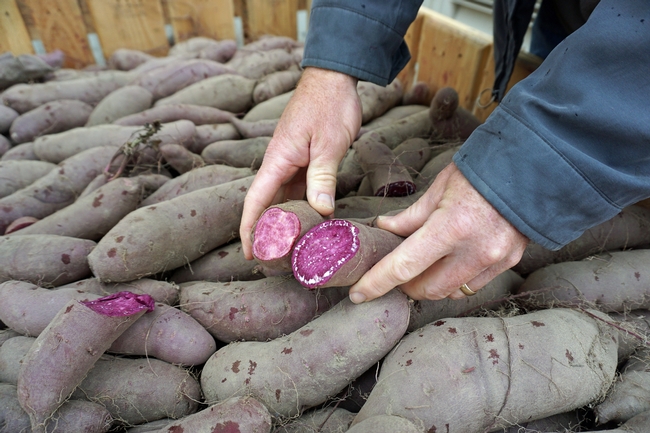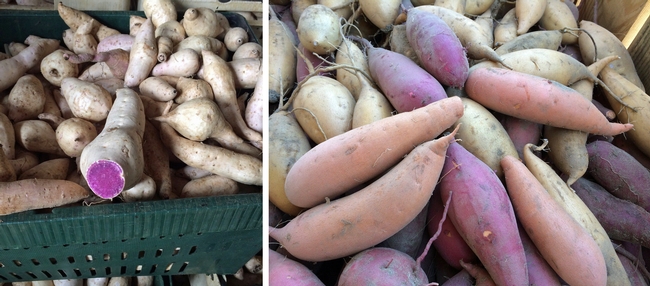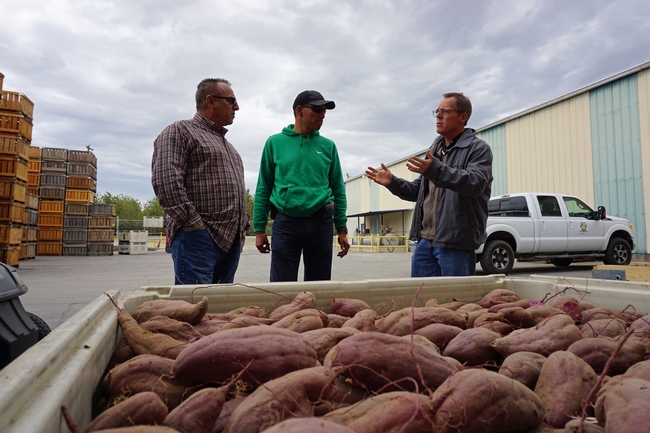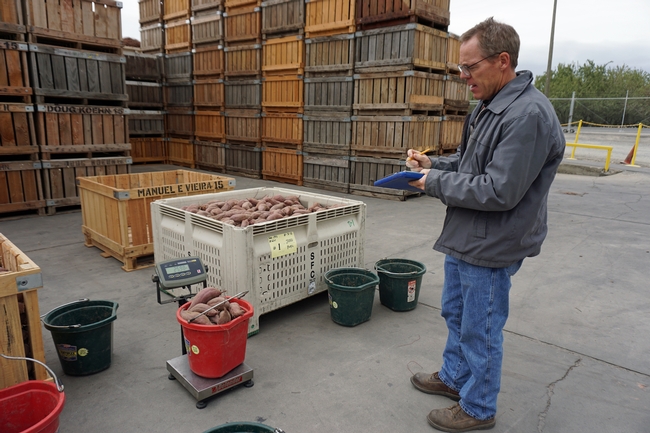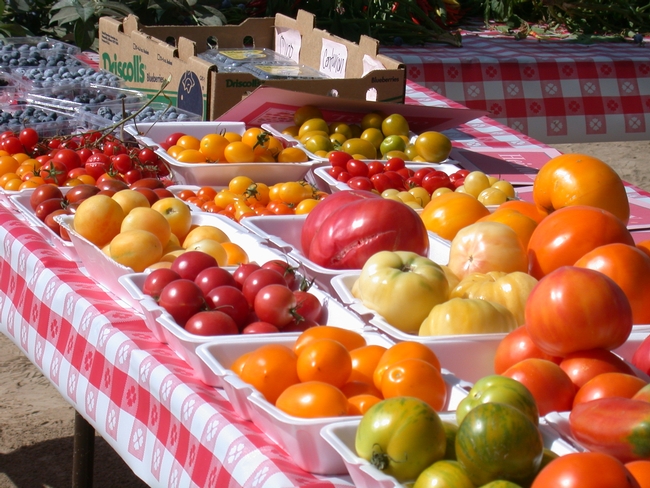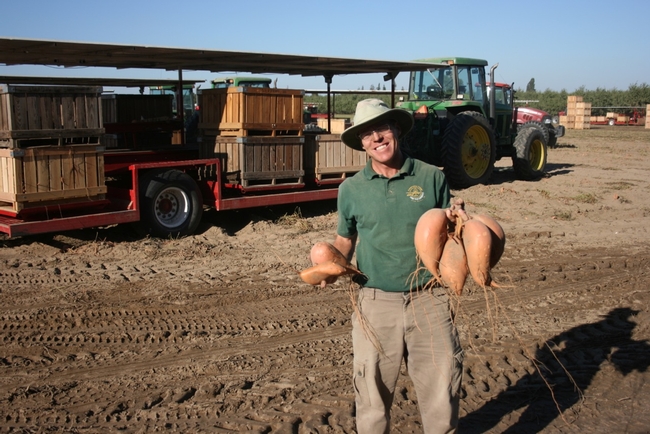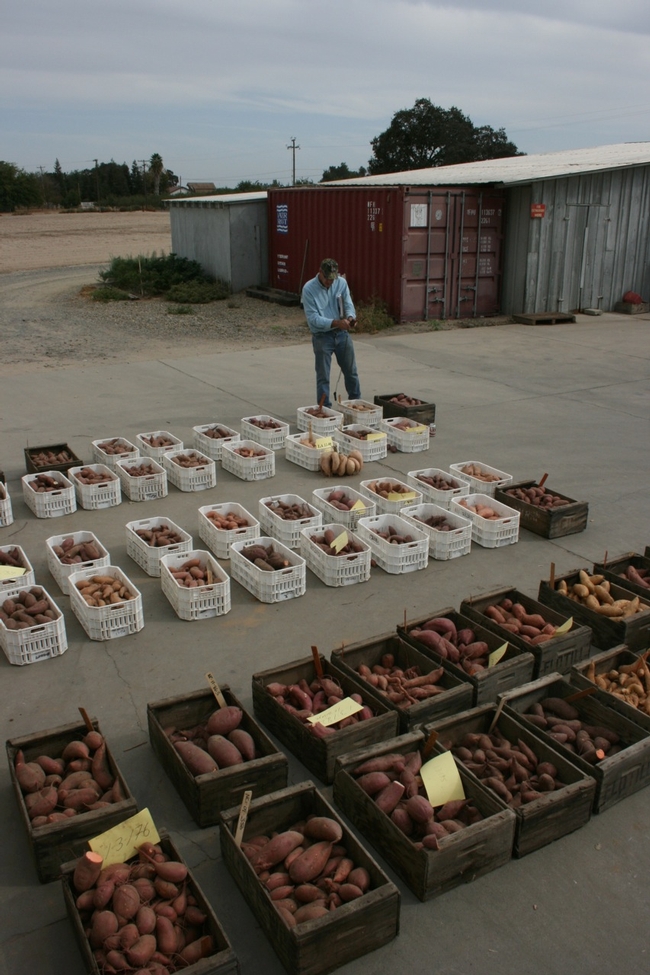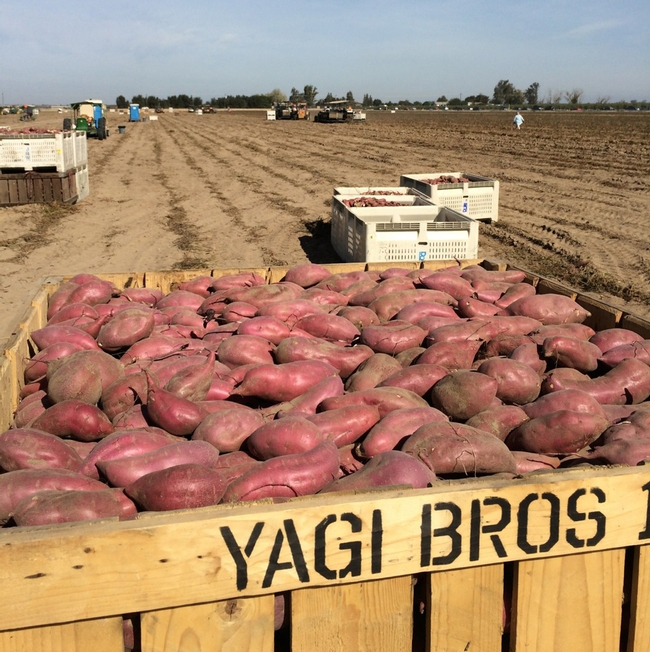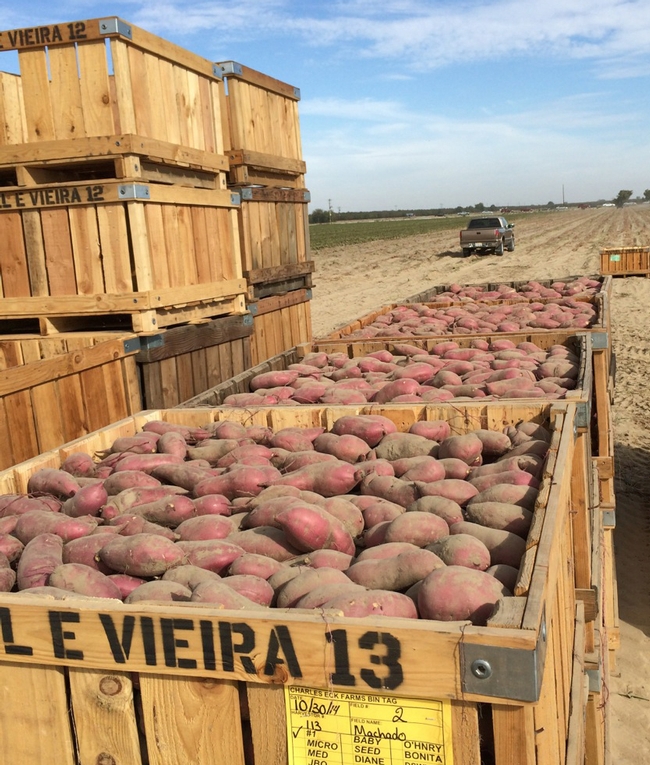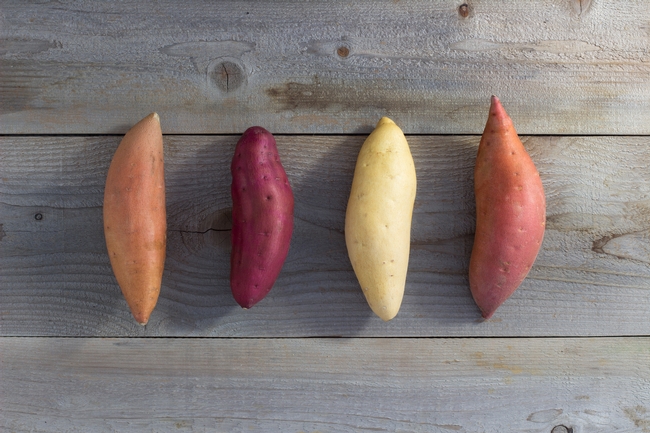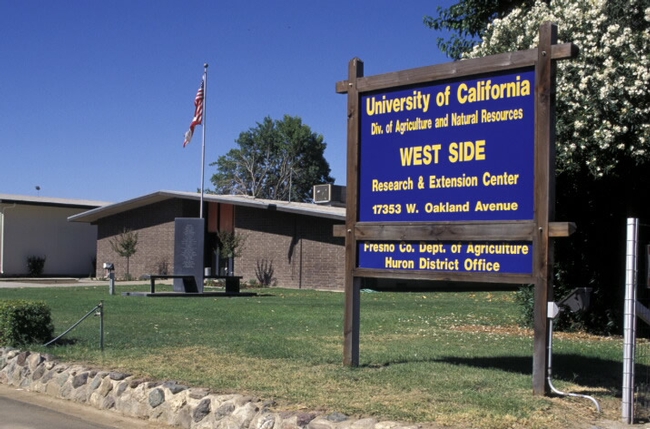Posts Tagged: Scott Stoddard
Vibrant purple sweet potatoes are a healthful Thanksgiving surprise
Candied sweet potatoes – dripping with butter, brown sugar and pecans – or a casserole of mashed sweet potatoes smothered with toasted marshmallows are common sides on the Thanksgiving table. These rich dishes belie the true nature of sweet potatoes, which are nutrient packed, low-glycemic root vegetables that can be a part of a healthy diet year round.
Research by UC Cooperative Extension advisor Scott Stoddard is aimed at making sweet potatoes an even more healthful and attractive food. Stoddard is working with sweet potato growers in Merced County to see if sweet potatoes with dusky purple skin and vibrant purple flesh, called purple/purples, can be grown by more farmers in California. The unusual color and health benefits command a higher price, opening a potentially profitable niche market.
“Purple flesh sweet potatoes have beta-carotene, like the more common orange varieties, plus anthocyanins,” Stoddard said. “It's like eating a handful of blueberries with your sweet potato.”
California is a significant producer of sweet potatoes. About 80 percent of the California crop – 16,000 acres – is grown in Merced County, on farms ranging from 5 acres up to several thousand acres. In 2015, the crop's value in Merced County was $195 million. About 1,000 acres are grown in Kern County and 2,000 acres in Stanislaus County. These locations have the sandy and sandy-loam soils ideal for sweet potatoes to develop their distinctive shape and smooth skin.
Sweet potatoes with purple flesh are not common, but they have been around for quite some time. They are the main type of sweet potato grown in Hawaii, for example. Several years ago, growers in Stokes County, N.C., selected a particularly beautiful and tasty cultivar, naming it the Stokes Sweet Potato and marketing nationwide with Frieda's Specialty Produce. In California, A. V. Thomas Produce in Livingston acquired an exclusive agreement with the company to grow and market Stokes purple/purple sweet potatoes.
“The number of acres of Stokes has really expanded in just a few years,” Stoddard said. "There is a lot of consumer interest in purple-fleshed sweet potatoes."
That doesn't close the door on purple/purples for California's other growers interested in the niche. Stoddard conducts field trials in cooperation with local farmers that include purple/purples. In one trial, 50 types of sweet potatoes of many different colors are being grown to determine whether they have key characteristics needed for local production. From there, he selects a limited number to grow in replicated trials, to determine their potential to produce a high yield, store well, and develop good size, shape, color and flavor. Of these, only one purple/purple made it into the replicated trial.
“In some purple/purples, the flavor can be off, or bitter,” Stoddard said. “We get rid of those right away.”
One of the cultivars in Stoddard's study, which goes by the experimental code number L-14-15-P, was bred in 2014 by Don La Bonte, a plant breeder at Louisiana State University, Baton Rouge. The potato has some good attributes, but lacks the uniform deep purple color of the Stokes variety.
“Unfortunately, it's probably not good enough to displace Stokes,” Stoddard said. “It's a good start, but we have to continue screening purple/purples to find a variety that offers disease resistance, good yield, and consistent deep purple flesh color."
Good eats
Sweet potatoes can be eaten raw or cooked. To eat raw, simply peel, cut into sticks and serve with low-fat ranch dressing or apple sauce for dipping. Grate fresh, uncooked sweet potatoes and add to burritos or tacos or sprinkle on salads for a sweet, nutritious crunch.
Cooked sweet potatoes can be eaten for breakfast, lunch or dinner, skin and all, plain or with a small pat of butter.
Microwaving is a great way to quickly prepare the vegetable. Wash potatoes and pat dry. Prick skin with a knife in 2 to 3 places. Cook on high for 5 minutes. Turn over. Then cook for another 5 minutes, more or less.
UC Cooperative Extension's sweet potato expert Scott Stoddard says he prefers his sweet potatoes baked.
“Baked is way better,” he said. “Baking gives time to convert the starch to maltose.”
Sweet potatoes are mostly starch, but have a special enzyme that breaks down starch into maltose when cooking. Slower cooking in the oven provides time for the conversion, imparting a subtly sweet caramelized flavor.
To bake, preheat the oven to 400 degrees. Line the lower oven rack with foil, then prick sweet potatoes with a fork and place directly on the middle oven rack, above the rack with foil. Bake 45 minutes for sweet potatoes 2 to 3 inches in diameter.
Grafting tomato transplants could improve taste and yield
Two UC Cooperative Extension advisors are conducting field research to determine whether grafting tasty tomato plants onto high-performing root stock will increase yield and disease resistance while improving tomato flavor, reported Ezra David Romero on Valley Public Radio.
Romero spoke to Scott Stoddard, the UCCE vegetable crops advisor for Madera and Merced counties, and Margaret Lloyd, the UCCE small farms advisor for Yolo, Solano and Sacramento counties.
Stoddard has planted 3,500 grafted tomato seedlings on a farm north of Madera.
“Now we got them in the field and so approximately 83 days from now, if all goes according to plan, we will be harvesting out here and we will see if we can see some yield differences,” Stoddard said.
Lloyd grafted heirloom tomato varieties onto disease-resistant roots on a quarter acre at UC Davis.
“We're kind of working at this level of finding non-chemical management tools that will help overcome these challenges so they [farmers] can continue to grow these nice heirloom varieties,” says Lloyd.
Both scientists will collect data from their trails to see whether it makes sense for growers to implement the practice on their farms. Romero reported that both agreed consumers could, in time, have a tastier, larger assortment of tomatoes to purchase at farmers markets and stores.
UCCE researcher seeks more colorful sweetpotatoes
Although you may call them candied yams, if they were grown in the U.S., the soft, orange roots you've smothered in butter and brown sugar are sweetpotatoes. If you don't add butter and sugar, sweetpotatoes are a healthful sweet treat, loaded with vitamins A, B-6, C and E and potassium and manganese.
In California, sweetpotato classes come in four colors:
- Tan Jewell with orange flesh
- Light yellow Jersey with white flesh
- Purple Oriental with white flesh
- Red Garnet with deep orange flesh
Scott Stoddard, UC Cooperative Extension advisor who evaluates sweetpotato varieties for production in California, is trying to identify lines with red and purple skin that grow and store well. It is a high priority for the industry because the Garnet class dominates many markets throughout the state. "Apparently, Californians like well-tanned sweetpotatoes, especially in Southern California," said Stoddard, who is based in Merced County.
“It's the same eye appeal as when people choose peaches,” Stoddard explained. “People tend to choose peaches with more red blush to the skin. Just as we tend to choose more colorful peaches, red-skinned sweetpotatoes are very popular, even more than the traditional tan skin sweetpotatoes that dominate in the rest of the United States.”
“The red variety is in high demand in LA, the Bay Area and Seattle markets,” said Jason Tucker, a grower and vice president of the CA Sweetpotato Council. “With our climate and sandy soil, we can grow any variety in California. It gives us so much flexibility and we're looking for new varieties. We can grow distinctive varieties, such as the Oriental variety, to meet demands even in other countries like Korea and Japan.”
Louisiana State University and North Carolina State University have the only two sweetpotato breeding programs in the U.S. For more than 50 years, UC has collaborated with the two universities in the National Sweetpotato Collaborators Trial, in which varieties are grown and evaluated in several states. Because the breeders are mainly interested in sweetpotatoes with light-colored skin, they used to discard the others. In 1998, Stoddard began screening their castoffs for high yields and sweet flavor in other colors.
“Sweetpotatoes are expected to be on shelves 12 months a year so we need one that will store up to a year,” said Stoddard. Sweetpotatoes are harvested from July through October so he is looking for a red-skinned sweetpotato that offers better nematode resistance and holds up in storage longer. “The white ones and Orientals store well, but the reds break down in June and July.”
In addition to high yields and consistent flavor in a variety, Tucker said, “We are looking for varieties that maintain a high level of sugar, or sucrose levels, smooth skin and a consistent shape with a distinct color – purple, red or white.”
Before Stoddard introduces a new variety to a California field, he has the plant material virus-tested by Foundation Plant Services at UC Davis.
A purple sweetpotato with white flesh called Murasaki is a variety that emerged from Stoddard's test plots in 2008 and is now being grown commercially. Burgundy, released in 2014, is the first variety with red skin and orange flesh released in 30 years. While Burgundy has better nematode resistance and improved storage characteristics, yields have failed to reach the numbers necessary to be commercially successful.
Sometimes when looking for a new red-skin cultivar, the UC Cooperative Extension advisor finds other desirable qualities. Stoddard is most excited about a tan-skin sweetpotato that he named Bellevue, after a road near the field where the variety was first evaluated and connects Atwater and Merced. “This variety has shown excellent yield potential combined with superior shape and skin quality in numerous test locations around the world, including North Carolina, Senegal, Israel and Australia,” he said. “It also has high nematode resistance and nice color. But it's not red, though ironically it came out of the red-skin trial.”
“It takes a few years to see if they will be successful,” Stoddard said. “Things always show up once you move from a small plot to millions of plants, that's when their true personality comes out. We'll see how they do in different soil and in different areas. All varieties have their own personality.”
About 300 acres of Bellevue were grown in California in 2014. Although it may only be grown in California, Bellevue is patented by LSU. The varieties are patented by LSU and NC State to provide funding for their breeding programs.
“Scott is a highly valuable asset to Merced County growers, he provides all of our sweetpotato research,” said Tucker. “He brings new varieties from North Carolina and Louisiana to California to find a new variety that works well in our soil and climate. He analyzes them so we can make better decisions about which varieties we will grow.”
About 90 percent of the estimated 20,000 acres of sweetpotatoes grown in the state are in Merced County, around Atwater and Turlock, where the soils are sandy.
What’s the difference between yams and sweetpotatoes?
Do you know the difference between a yam and a sweetpotato?
“A true yam is not grown in the U.S., it's found in South America,” says Jason Tucker, vice president of the California Sweetpotato Council. Real yams have dry, dark flesh and are not the same plant species as sweetpotatoes, he explained.
“A yam is a sweetpotato, at least for those grown in the U.S.”, says Scott Stoddard, UC Cooperative Extension advisor in Merced County. “The rest of country has predominately just one type of sweetpotato, with tan skin and orange flesh, but in California, we have four marketing classes.”
The four kinds of California sweetpotatoes are
- Jewell, with tan skin and orange flesh
- Jersey, with light yellow skin and white flesh
- Oriental, with purple skin and white flesh
- Garnet, with red skin and deep orange flesh
The red-skinned sweetpotatoes are what many people in the United States call yams.
The California Sweetpotato Council spells sweetpotato as one word because it isn't a potato, it is a different plant species.
Agriculture research not immune to drought
Fitchette opened his story with the plight of ag research at the UC West Side Research and Extension Center near Five Points. Many of the farmers in the area will receive no surface water allocation this year; neither will the research center.
The facility can pull water from a deep well, but it is not enough nor is the water quality adequate for all the farming operations, said Bob Hutmacher, UC Cooperative Extension specialist and center director. He said scientists at the station must cut back their water use this year by 25 percent.
“I can speak for myself: I have about a half dozen cotton projects and a sorghum project, along with a sesame project and a couple of other things I'm working on,” he said. “I'm downsizing most of them to the greatest degree I can and I'm going to cancel one of them.”
One trial that will not go forward at West Side is an almond variety trial. However, UC Cooperative Extension advisors in other areas are working with the Almond Board to keep the research underway. UCCE advisors Joe Connell will oversee the Chico State almond variety trial, Roger Duncan the Salida trial, and Gurreet Brar the Madera County trial.
The Western Farm Press Story included drought-related ag research news from myriad UCCE academics:
- Duncan said his work with fruit and nut crops has not been negatively impacted by the drought.
- David Doll, UCCE advisor in Merced County, said the increased reliance on groundwater has ruined several orchard nitrogen trials because the groundwater in northern Merced has high rates of nitrate nitrogen, which acts as a nitrogen fertilizer.
- Dan Munk, UCCE advisor in Fresno County, said he will continue putting off alfalfa trials at the WSREC “indefinitely until a more secure water supply is available.”
- Scott Stoddard, UCCE advisor in Merced County, reports positive and negative impacts from the drought. He won't do tomato research at West Side REC, but will continue work in sweet potatoes to determine how little water they need to produce a reasonable crop.
- Chris Greer, UCCE advisor in Sutter, Yuba, Colusa and Glenn counties, said some rangeland trials were impacted by the lack of rain.
- Bruce Lampinen, UCCE specialist in the Department of Plant Sciences at UC Davis, has seen his orchard trials in Arbuckle severely impacted by the drought.

